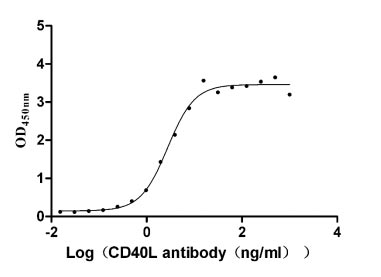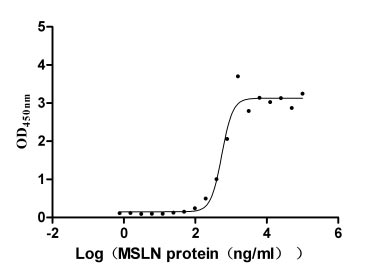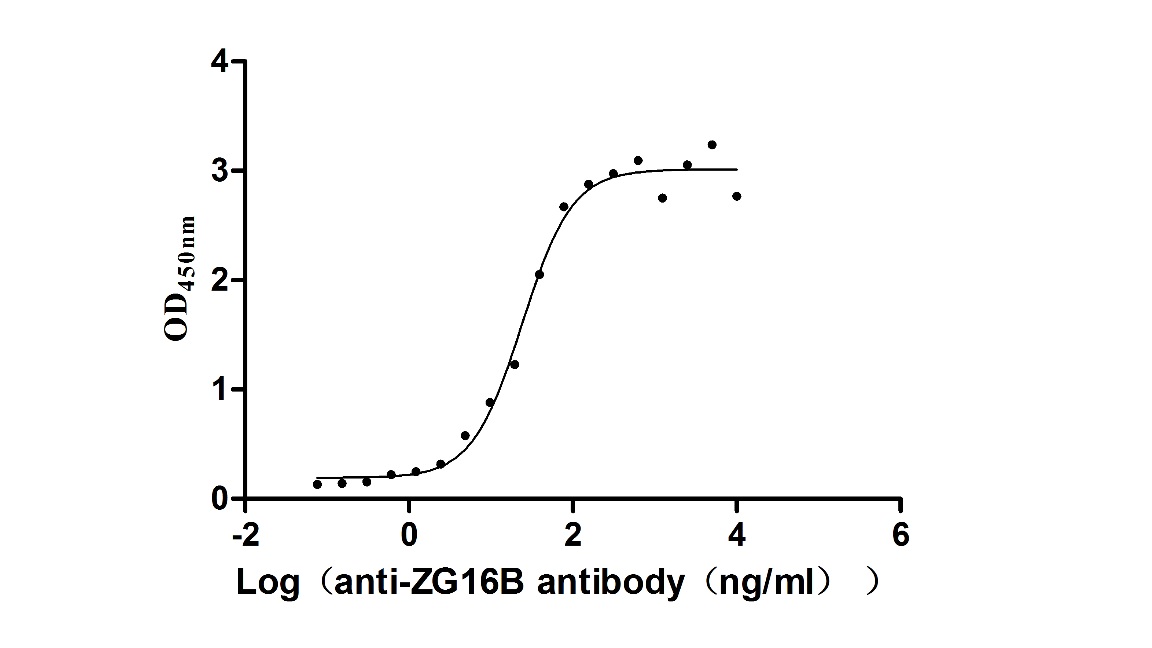Recombinant Mouse Beta-1 adrenergic receptor (Adrb1)
Unavailable-
中文名称:
-
货号:CSB-CF001391MO
-
规格:¥9720
-
图片:
-
其他:
产品详情
-
纯度:Greater than 85% as determined by SDS-PAGE.
-
基因名:
-
Uniprot No.:
-
别名:(Beta-1 adrenoreceptor)(Beta-1 adrenoceptor)
-
种属:Mus musculus (Mouse)
-
蛋白长度:Full Length
-
来源:in vitro E.coli expression system
-
分子量:63.4 kDa
-
表达区域:1-466aa
-
氨基酸序列MGAGALALGASEPCNLSSAAPLPDGAATAARLLVLASPPASLLPPASEGSAPLSQQWTAGMGLLLALIVLLIVVGNVLVIVAIAKTPRLQTLTNLFIMSLASADLVMGLLVVPFGATIVVWGRWEYGSFFCELWTSVDVLCVTASIETLCVIALDRYLAITSPFRYQSLLTRARARALVCTVWAISALVSFLPILMHWWRAESDEARRCYNDPKCCDFVTNRAYAIASSVVSFYVPLCIMAFVYLRVFREAQKQVKKIDSCERRFLGGPARPPSPEPSPSPGPPRPADSLANGRSSKRRPSRLVALREQKALKTLGIIMGVFTLCWLPFFLANVVKAFHRDLVPDRLFVFFNWLGYANSAFNPIIYCRSPDFRKAFQRLLCCARRAACRRRAAHGDRPRASGCLARAGPPPSPGAPSDDDDDDAGTTPPARLLEPWTGCNGGTTTVDSDSSLDEPGRQGFSSESKV
Note: The complete sequence including tag sequence, target protein sequence and linker sequence could be provided upon request. -
蛋白标签:N-terminal 6xHis-SUMO-tagged
-
产品提供形式:Liquid or Lyophilized powder
Note: We will preferentially ship the format that we have in stock, however, if you have any special requirement for the format, please remark your requirement when placing the order, we will prepare according to your demand. -
缓冲液:If the delivery form is liquid, the default storage buffer is Tris/PBS-based buffer, 5%-50% glycerol.If the delivery form is lyophilized powder, the buffer before lyophilization is Tris/PBS-based buffer, 6% Trehalose, pH 8.0.
-
复溶:We recommend that this vial be briefly centrifuged prior to opening to bring the contents to the bottom. Please reconstitute protein in deionized sterile water to a concentration of 0.1-1.0 mg/mL.We recommend to add 5-50% of glycerol (final concentration) and aliquot for long-term storage at -20℃/-80℃. Our default final concentration of glycerol is 50%. Customers could use it as reference.
-
储存条件:Store at -20°C/-80°C upon receipt, aliquoting is necessary for mutiple use. Avoid repeated freeze-thaw cycles.
-
保质期:The shelf life is related to many factors, storage state, buffer ingredients, storage temperature and the stability of the protein itself.
Generally, the shelf life of liquid form is 6 months at -20°C/-80°C. The shelf life of lyophilized form is 12 months at -20°C/-80°C. -
货期:Delivery time may differ from different purchasing way or location, please kindly consult your local distributors for specific delivery time.
-
注意事项:Repeated freezing and thawing is not recommended. Store working aliquots at 4°C for up to one week.
-
Datasheet & COA:Please contact us to get it.
相关产品
靶点详情
-
功能:Beta-adrenergic receptors mediate the catecholamine-induced activation of adenylate cyclase through the action of G proteins. This receptor binds epinephrine and norepinephrine with approximately equal affinity. Mediates Ras activation through G(s)-alpha- and cAMP-mediated signaling. Involved in the regulation of sleep/wake behaviors.
-
基因功能参考文献:
- Cardiac specific expression of the mutated Cav1.2PKA_P2(-/-) gene reduces Cav1.2 alpha1c protein concentration, calcium current (ICa), and the beta-adrenergic stimulation of L-type ICa in cardiomyocytes. PMID: 28778765
- Proliferation in cardiac fibroblasts induced by beta1-adrenoceptor autoantibody results in endomyocardial fibrosis. PMID: 27577254
- the present study demonstrated that cardiac contractility/relaxation and heart rate is increased in beta1AR TG and beta2AR TG mice, and indicated that this increase may be related to the overexpression of G proteins and Gproteinassociated proteins. PMID: 28487987
- ghrelin has a critical role in preventing hypoglycemia and promoting survival during severe caloric restriction, a process that requires cell-expressed beta1AR PMID: 27548523
- knocking out of the beta1/2 receptor significantly diminished the ST25 acupuncture-induced inhibition of gastric motility and jejunal motility without significantly altering the enhancement of colonic motility induced by acupuncture at ST25. PMID: 27978539
- Computer simulations model the responses to moderate stimulation/inhibition of the beta1-adrenergic signaling system and its components in mouse ventricular myocytes. PMID: 26936457
- Our findings that BAG3 is localized at the sarcolemma and t-tubules while modulating myocyte contraction and action potential duration through specific interaction with the beta1-adrenergic receptor and L-type Ca(2+) channel provide novel insight into the role of BAG3 in cardiomyopathies and increased arrhythmia risks in heart failure. PMID: 26796036
- Galphai2 deficiency combined with cardiac beta1-adrenoceptor overexpression strongly impaired survival and cardiac function, leading to dilated cardiomyopathy. PMID: 26464333
- Knockout of the C5aR1 attenuated the effect of beta1-AR in the heart, suggesting an association between the beta1-AR and C5aR1, although further investigation is required to determine if this is a direct or causal association PMID: 26727203
- The beta1-AR may play an important role in the development of atrial fibrillation. PMID: 26203906
- Partial gap junction uncoupling increased propensity and amplitude of Ca(2+) alternans, and made them more sensitive to reversal by beta-AR activation, as in isolated myocytes. PMID: 25828762
- These data reveal a novel interplay between the E2F pathway, beta2-adrenergic/PKA/PDE4D, and ERK/c-Src axis in fine tuning the pathological hypertrophic growth response. PMID: 25944088
- Myocardial adrenergic receptor beta 1 preferentially associates with AC5. PMID: 25677623
- role of beta-ARs in early muscle regeneration PMID: 25000590
- Phosphorylation of beta1-AR by PKA stimulates active Ca(2+)influx through TRPV5. PMID: 24828496
- Sustained beta1-adrenoceptor activation in the diseased heart exacerbates left ventricular remodelling and therefore may promote disease progression from compensatory hypertrophy to heart failure PMID: 23750586
- This study report that both beta1- and beta2-ARs are expressed in a majority of GABAergic interneurons in the medial prefrontal cortex of mice. PMID: 24215978
- Calcium {Ca(2+)} entry through beta-adrenergic-stimulated LTCC underlies hypoxia-induced [Ca(2+)]i overload and the ensuing loss of mitochondrial function in intact heart. PMID: 24041537
- Data indicate that ischemic injury coupled to G protein-coupled receptor beta1/2 adrenergic receptors activation required GRK2 (GPCR kinase 2) activation. PMID: 24170934
- Our findings indicate a novel function for beta1AR-mediated beta-arrestin1 signaling activated by carvedilol in miR biogenesis. PMID: 24334028
- a significant role for the AKAP5 scaffold in signaling and trafficking of the beta1-AR in cardiac myocytes and mammalian cells. PMID: 24121510
- beta1-adrenergic receptor recycles via a membranous organelle, recycling endosome, by binding with sorting nexin27. PMID: 23780416
- We demonstrate that restoration of cardiac plasma membrane levels of S1PR1 produces beneficial effects that counterbalance the deleterious beta1AR overstimulation in heart failure. PMID: 23969695
- Canonical betaAR-mediated signaling coupled to PKA activation results in phosphorylation of spinophilin, disrupting its interaction with alpha2AARs and accelerating alpha2AAR endocytic responses. PMID: 23965992
- CREB-binding protein (CBP) regulates beta-adrenoceptor (beta-AR)-mediated apoptosis. PMID: 23579242
- TNFalpha-induced betaAR desensitization is mediated by GRK2 and is independent of Gbetagamma, uncovering a hitherto unknown cross-talk between TNFalpha and betaAR function, providing the underpinnings of inflammation-mediated cardiac dysfunction. PMID: 23785004
- Adrb1 activates Epac2 to induce sarcoplasmic reticulum calcium leakage via a pathway that contributes to arrhythmia and reduced cardiac function. PMID: 23363625
- In muscararinic M2 receptor knockout mice,heart function is not much affected; as possible mechanisms of this normal cardiac function, decreases of gene expression and receptor binding of beta1- and beta2-adrenoceptors should be considered PMID: 23093370
- A potential cooperative role for beta(1) and beta(2) adrenergic receptors in stress-induced reinstatement. PMID: 22593095
- The beta(1) signaling pathway mediates most of the sympathetic nervous system stimulation of adaptive thermogenesis. PMID: 22728333
- beta1- and beta2-adrenergic signaling exert opposite effects on bone- beta1 exerting a predominant anabolic stimulus in response to mechanical stimulation and during growth, whereas beta2-adrenergic receptor signaling mainly regulates bone resorption during aging. PMID: 22407956
- Data show that overexpression of beta1- and beta2-adrenergic receptors in hepatocytes from young mice and rats increased cellular lipid content. PMID: 22457517
- Norepinephrine regulates intestinal mucosal immune responses mediated by intestinal intraepithelial lymphocytes via beta adrenoreceptors. PMID: 22398028
- Induction of Fos by ssadrenergic signaling is critical for the full activation of CA1 pyramidal neurons in response to excitatory input from CA3 pyramidal neurons conveying retrieved contextual information. PMID: 21377513
- beta-Adrenergic receptor-PI3K signaling crosstalk in mouse heart PMID: 22028912
- Confinement of beta 1- and beta 2-adrenergic receptors in the plasma membrane of cardiomyocytes is mediated by selective interactions with PDZ domain and A-kinase anchoring proteins PMID: 21680711
- High (stress) levels of epinephrine directly compromise the activity of neonatal mouse skin fibroblasts through the activation of beta1-, beta2- and beta3-adrenoceptors, but not through alpha1- and alpha2-adrenoceptors. PMID: 21366703
- renin expression was found to be significantly lower at all developmental stages in the kidneys of adrenergic beta(1)/beta(2) knockout mice PMID: 21389089
- b1-adrenoceptors are the predominant b-adrenoceptor in mouse astrocytes and are primarily responsible for cAMP production in response to b-adrenoceptor stimulation PMID: 21138422
- negative inotropy and heart hypertrophy occur in total adrenergic beta receptor deficiency PMID: 20406048
- Results suggest that catecholamines induce myocyte necrosis primarily through beta(1)-AR-mediated increases in L-type calcium channel activity, but other mechanisms are also involved in rodents. PMID: 20495143
- the unique signaling effects of enhanced beta(2)AR and AC5, which have the potential to afford benefit in heart failure, failed to salvage ventricular function in beta(1)AR-mediated cardiomyopathy. PMID: 20443853
- beta-Adrenergic receptors transmit sympathetic signals to the ion secretory elements of the colonic epithelial cells stimulating a transient Cl ion secretion and a sustained K ion secretion. PMID: 20413718
- This work has provided insight into the intracellular signaling pathways and transcription factors regulating Ncx1 gene expression in a chronically beta-AR-stimulated heart. PMID: 19945464
- [beta]1-AR play a significant role in regulating LPS-mediated mortality and inflammation. PMID: 19333138
- vasoconstrictor role for vascular alpha1B-adrenoceptors in mouse PMID: 12006674
- Pathogenesis of DCM in CREB(A133) mice does not appear to involve abnormal betaAR signaling PMID: 12054854
- modulates receptor trafficking and signaling in cardiac myocytes PMID: 12097326
- betaAR signaling required for diet-induced thermogenesis and obesity resistance. PMID: 12161655
- role in obesity and cold sensitivity and response to fasting PMID: 12387862
显示更多
收起更多
-
亚细胞定位:Cell membrane; Multi-pass membrane protein. Early endosome.
-
蛋白家族:G-protein coupled receptor 1 family, Adrenergic receptor subfamily, ADRB1 sub-subfamily
-
组织特异性:In brain, expressed by glutamatergic and GABAergic neurons of the dorsal pons (at protein level).
-
数据库链接:
KEGG: mmu:11554
STRING: 10090.ENSMUSP00000040847
UniGene: Mm.46797
Most popular with customers
-
Recombinant Human CD40 ligand (CD40LG), partial (Active)
Express system: Mammalian cell
Species: Homo sapiens (Human)
-
Recombinant Human Mucin-16 (MUC16), partial (Active)
Express system: Mammalian cell
Species: Homo sapiens (Human)
-
Recombinant Human Tumor necrosis factor ligand superfamily member 8 (TNFSF8), partial (Active)
Express system: Mammalian cell
Species: Homo sapiens (Human)
-
Recombinant Human E3 ubiquitin-protein ligase ZNRF3 (ZNRF3), partial (Active)
Express system: Mammalian cell
Species: Homo sapiens (Human)
-
Recombinant Mouse Transthyretin (Ttr) (Active)
Express system: Mammalian cell
Species: Mus musculus (Mouse)
-
Recombinant Human Claudin-6 (CLDN6)-VLPs (Active)
Express system: Mammalian cell
Species: Homo sapiens (Human)
-
Recombinant Macaca fascicularis zymogen granule protein 16 homolog B (ZG16B) (Active)
Express system: Mammalian cell
Species: Macaca fascicularis (Crab-eating macaque) (Cynomolgus monkey)
-
Recombinant Human Interleukin-2 receptor subunit alpha (IL2RA), partial (Active)
Express system: Mammalian cell
Species: Homo sapiens (Human)








-AC1.jpg)












